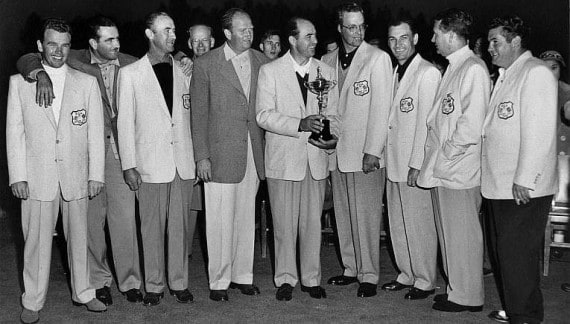College football has always been a big deal in the South.
And in the past, it’s even been a big deal in golf. Seriously.
In fact, college football once interrupted the Ryder Cup.
On purpose.
It was in 1951, when Pinehurst No. 2 hosted the ninth playing of the Ryder Cup. Granted, the Ryder Cups of this period were not the massive spectacles they are today. Only 30 correspondents – including just three from London and three from Scotland – made the trip to the North Carolina Sandhills to cover the event.
And it wasn’t just the coverage. About 6,000 spectators came in each day to watch, and play among Pinehurst Resort guests even continued on courses Nos. 1, 3 and on nine holes of No. 4.
Still, it wasn’t like there was a lack of star power. Sam Snead played and captained the team. The world’s best player at the time, Ben Hogan, was a stalwart. Others like Jack Burke Jr., Jimmy Demaret and Lloyd Mangrum also starred for the United States, which won handily 9 ½-2 ½.
But that wasn’t all that made this Ryder Cup different. So, too, did a college football game about 70 miles north.
In 1951, the Ryder Cup only needed two days to be played – a day of foursomes to start and a second round of eight 36-hole singles matches. But in Pinehurst, those rounds were played on a Friday and a Sunday.

The 1951 United States Ryder Cup team.
In between, on Saturday, Nov. 3, the event stalled as the two teams traveled to Chapel Hill as special guests to attend the football game between the Tennessee Vols and the North Carolina Tar Heels at Kenan Stadium.
Yes, a relatively meaningless November college game that Tennessee won 27-0 interrupted the Ryder Cup. Still, it must have been important to somebody.
“They said, ‘In North Carolina when Carolina plays Tennessee in a football game on Saturday, nobody watches golf,’” U.S. golfer Skip Alexander recalled decades later. “So they took the day off and we all went to the football game.”
Few, though, especially from across the pond, were impressed.
“They tried to tell me that this was a tough-guy game, a piece of legalized mayhem that made bullfighting look sissy,” wrote Desmond Hackett of the London Daily Express (reported by Lee Pace in 2014). “No sir. Any professional rugby club in England could eliminate the heavily armored characters who amble in and out of this game.”
Snead didn’t think much of the matchup either, skipping it to attend a paid exhibition in South Carolina.
A day later, the players were back on No. 2, which then played to a grueling-at-the-time 7,007 yards. The game, though, still managed to influence the Ryder Cup in another way.
“It was cold and (Dutch) Harrison got sick and Snead came to me and said, ‘Can you play?’” Alexander said. “I told him, ‘Yes, I can play.’”
All because of college football.

